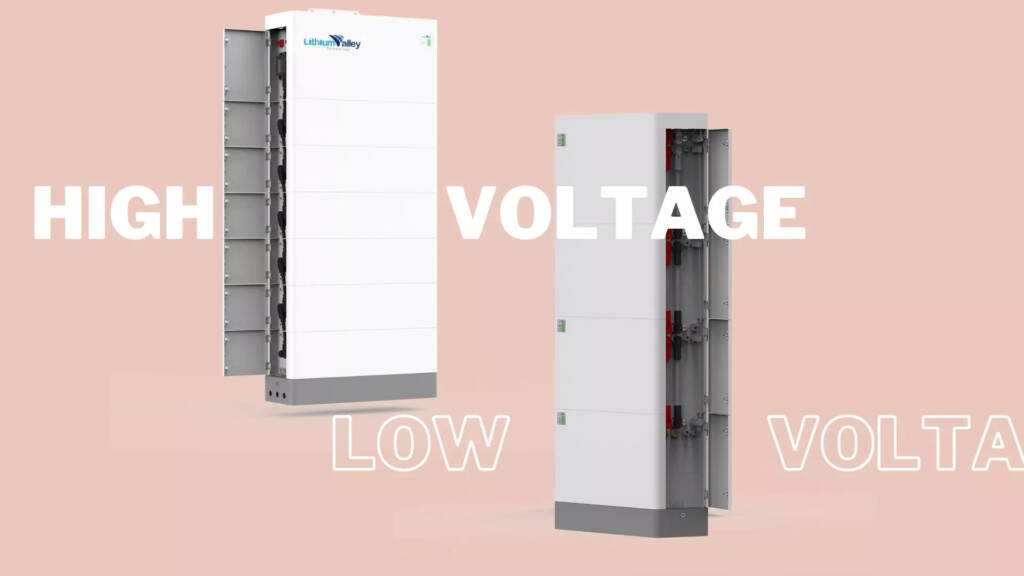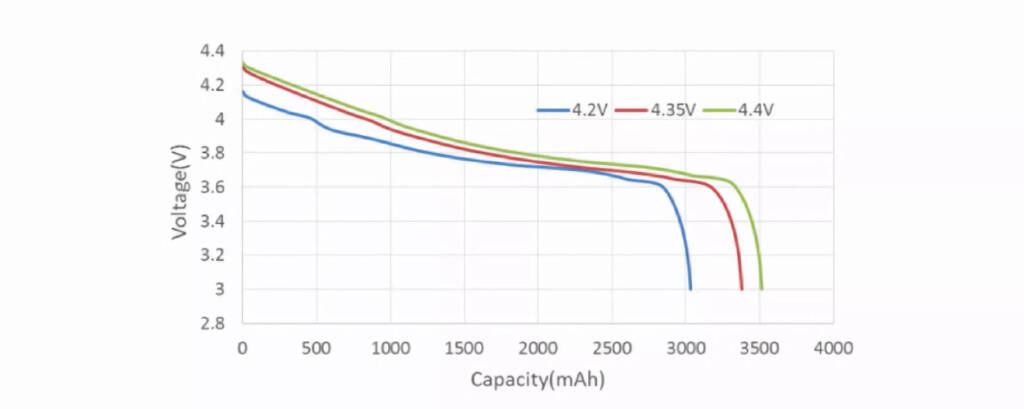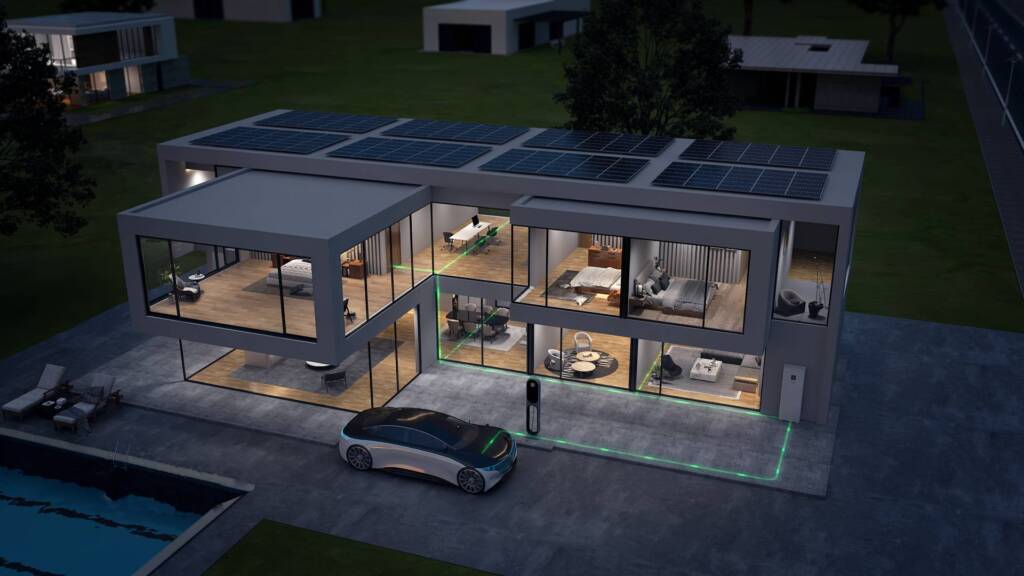
In the context of residential energy storage, choosing between a high-voltage battery and a low-voltage battery is a common question that arises. While most people are aware that high-voltage batteries operate at higher voltages, they may not fully understand the differences between the two. Low-voltage battery systems typically operate at voltages below 100V, while high-voltage battery systems operate at voltages exceeding 100V, typically falling in the range of 250V to 300V. To help guide your decision-making process when selecting an energy storage battery, this article outlines some key differences between high-voltage and low-voltage batteries.
Energy Density

In real-world scenarios, higher voltage generally corresponds to higher energy density. For instance, when the lithium-ion voltage is increased from 4.2V to 4.35V, the energy density can increase by roughly 16%. This discrepancy in energy density results in high-voltage batteries being smaller and lighter in weight than their low-voltage counterparts of the same capacity.
Load Capacity
High-voltage batteries are capable of supporting higher load demands than low-voltage batteries due to their higher discharge rates. With a higher discharge rate, they can charge and discharge more quickly, providing the necessary power to meet rapid demand surges and power-up equipment. In contrast, low-voltage batteries may not be able to start certain devices that require a high instant charging rate during low-voltage battery charging.
Conversion Efficiency
The high-voltage battery system boasts higher conversion efficiency compared to low-voltage batteries, mainly due to the DC bus voltage typically ranging between 300 and 500V on the photovoltaic side of residential systems. In contrast, the inverter in low-voltage battery systems needs to lower the input voltage, which can reach 300-500V or higher, to below 100V. Unfortunately, this process incurs significant energy loss, resulting in lower overall operating efficiency of the energy storage system.
Service Life
High-voltage batteries typically have a longer service life due to their relatively smoother discharge curve, which means that frequent use has less impact on their lifespan. Additionally, high-voltage battery systems are less likely to overheat during use, which minimizes the potential for hidden dangers and further contributes to their extended service life.
Battery Management System
The primary distinguishing factor between low-voltage BMS and high-voltage BMS lies in the voltage range they are designed to handle. Typically, low-voltage BMS is suitable for batteries below 192V, while high-voltage BMS is designed for batteries above 192V. Assembling, managing, and maintaining high-voltage battery packs is relatively more complex, and consequently, the architecture of high-voltage BMS demands higher measurement accuracy and connection reliability.

Lithium Valley's high-voltage products have successfully passed a series of rigorous certifications such as IEC62040, EN62040, and more in Europe and America. These products can be effectively employed in various scenarios that demand higher quality standards, including households, commercial buildings, industrial fields, and power grids. However, low-voltage products still hold a significant market share due to their price advantage and well-established manufacturing processes. If you seek a reliable and certified energy storage battery supplier, Lithium Valley is an excellent choice. Please feel free to contact us.
- 3C batteries (1)
- 48C Advanced Energy Project Credits (1)
- ActiveBalancing (1)
- Advanced Storage Solutions (1)
- advanced technologies (1)
- African market (1)
- AI Algorithms (1)
- AI in Energy Storage (1)
- air conditioning (1)
- All-in-One Energy Storage (1)
- American electricity market (1)
- ancillary services market (1)
- application scenarios (2)
- Arnstadt (1)
- automotive industry (1)
- backup generators (1)
- Backup power (1)
- batteries (2)
- Battery Discharge (1)
- Battery Energy Storage (1)
- Battery Energy Storage Systems (1)
- Battery Energy Storage Systems (BESS) (1)
- battery factory (1)
- battery industry event (1)
- battery management system (3)
- battery management systems (1)
- battery market (1)
- battery materials (1)
- battery pack (1)
- Battery Storage Safety (1)
- Battery technologies (1)
- battery technology advancements (1)
- battery type (1)
- BatteryLongevity (1)
- BatteryManagementSystem (1)
- BatterySafety (1)
- BatteryTechnology (1)
- BESS (1)
- Birmingham Exhibition (1)
- BMSArchitecture (1)
- Brazil energy storage (1)
- Burkina Faso (1)
- Capacity (1)
- capacity rule (1)
- carbon management (1)
- carbon neutrality goals (1)
- CATL (1)
- CE marking (1)
- certification (1)
- certifications (1)
- Charge Current (1)
- Charge/Discharge Rate (1)
- Chemical Storage (1)
- China electricity market (1)
- China International Battery Fair (1)
- CIBF 2023 (1)
- Clean energy (6)
- clean energy incentives (1)
- Clean Energy Revolution (1)
- clean energy solutions (1)
- Climate Goals (1)
- Climate Legislation (1)
- Commercial (1)
- Commercial Energy Storage (2)
- CompleteCurrentControl (1)
- Compressed Air Energy Storage (CAES) (1)
- consumer batteries (1)
- Containerized Energy Storage (1)
- Continuous Discharge Duration (1)
- conversion efficiency (1)
- Cooperation (1)
- cost composition (1)
- cost parity (1)
- cost reduction (1)
- Cost-effective storage (1)
- critical power (2)
- CSA certification (1)
- Customized Energy Storage (1)
- DC bus voltage (1)
- Decarbonization (1)
- Decarbonized future (1)
- Demand Forecasting (1)
- Department of Energy (1)
- DesignConsiderations (1)
- development strategies (1)
- Direct Pay (1)
- Discharge Current (1)
- discharge curve (1)
- Distributed Energy (1)
- Dongguan Lithium Valley (2)
- dual carbon goal (1)
- Dubai World Trade Center (1)
- efficient energy storage (1)
- Electric Vehicle Charging (1)
- Electric Vehicles (2)
- Electricity Costs (1)
- Electricity Infrastructure Operations Center (1)
- electricity market (1)
- electricity price mechanism (1)
- electricity prices (1)
- electricity supply (1)
- electrochemical energy storage (1)
- Electrochemical Storage (1)
- Energy Certification (1)
- Energy Community Adder (2)
- energy companies (1)
- energy consumption (1)
- energy consumption management (1)
- energy crisis (1)
- Energy Demand (1)
- Energy Demands (1)
- energy density (2)
- energy distribution (1)
- Energy Efficiency (1)
- energy industry (1)
- Energy Industry Solutions (1)
- energy investment (1)
- Energy Landscape (1)
- Energy Management System (3)
- energy management systems (1)
- energy professionals (1)
- energy sector (1)
- energy solutions (2)
- Energy storage (16)
- Energy Storage Batteries (3)
- Energy storage battery business (1)
- Energy Storage Battery Industry (1)
- Energy Storage Battery Technology (1)
- energy storage business model (1)
- Energy Storage Cabinets (1)
- energy storage capacity (1)
- Energy Storage Certification (1)
- Energy Storage Challenges (1)
- energy storage components (1)
- energy storage converters (1)
- energy storage equipment (1)
- Energy Storage Incident (1)
- energy storage industry (4)
- energy storage market (1)
- Energy Storage Products (1)
- energy storage profitability (1)
- energy storage projects (1)
- Energy storage research (1)
- Energy Storage Solution (2)
- Energy Storage Solutions (4)
- Energy Storage System (3)
- energy storage system solutions (1)
- Energy Storage Systems (5)
- Energy Storage Technologies (2)
- Energy Supplies (1)
- Energy Supply Challenges (1)
- Energy Transition (1)
- energy trends (1)
- EnergyEfficiency (1)
- EnergyStorage (1)
- Environmental Innovation (1)
- environmental sustainability (1)
- ESS chain (1)
- EU countries (1)
- European battery factory (1)
- European electricity market (1)
- European Market (1)
- European Solar Market (1)
- Exhibitors (1)
- Extended Tax Credits (1)
- field study (1)
- financing options (1)
- fire protection systems (1)
- Flexibility (2)
- Flow batteries (2)
- Flywheel Energy Storage (1)
- Fossil Fuel Emissions (1)
- fossil fuels (1)
- generation side (1)
- Germany (2)
- Gigawatts (1)
- Global Carbon Emissions (1)
- global energy storage (1)
- global market share (1)
- global power batteries (1)
- government officials (1)
- Government Support (1)
- granular silicon (1)
- Green Energy Initiatives (1)
- Green Living (1)
- Green Technology (2)
- Greenhouse Gas Emission Verification (1)
- grid (1)
- Grid reliability (2)
- grid resilience (1)
- grid side (1)
- Grid Stability (3)
- Grid Storage Launchpad (1)
- grid voltage (1)
- grid-connected (1)
- Guide (1)
- high-voltage battery (1)
- higher discharge rate (1)
- Home Energy Storage (3)
- Home Energy Storage Benefits (1)
- household energy storage (2)
- hydropower (1)
- I&C energy storage (1)
- IEC 62619 (2)
- IEEE 1547 (1)
- inductive loads (1)
- Industrial (1)
- industrial and commercial energy storage (1)
- industrial and commercial track (1)
- Industrial Energy Storage (6)
- Industry Trends (1)
- IndustryStandards (1)
- Inflation Reduction Act (1)
- Inflation Reduction Act (IRA) (1)
- installed energy storage (1)
- integrated energy storage cabinet (1)
- integration (1)
- intelligent solutions (1)
- Intermittency (1)
- International Energy Agency (1)
- International Energy Agency (IEA) (1)
- International Energy Storage Exhibition (1)
- Intersolar (1)
- Intersolar Europe 2023 (1)
- Intersolar Middle East (1)
- Intertek (1)
- inverter (2)
- inverter power (1)
- Investment (1)
- Investment Tax Credits (1)
- ISO 14001 (1)
- ISO 9001 (1)
- ITC (1)
- Johannesburg (1)
- large size silicon (1)
- large-scale energy storage (1)
- Leveraging Solar Power (1)
- life cycles (1)
- LiFePO4 batteries (1)
- lithium batteries (1)
- lithium iron phosphate batteries (2)
- Lithium Prices (1)
- Lithium Valley (14)
- Lithium Valley Products (1)
- Lithium Valley Technology (1)
- Lithium-ion alternatives (1)
- Lithium-Ion Batteries (3)
- lithium-ion battery cells (1)
- lithium-ion voltage (1)
- load capacity (1)
- Long Beach California (1)
- Long Duration Energy Storage (1)
- Long-duration storage (2)
- Low-carbon Future (1)
- low-voltage battery (1)
- LS Energy Solutions (1)
- M&A project (1)
- manufacturing equipment (1)
- Market Opportunities (1)
- market-oriented (1)
- Mechanical Storage (1)
- MEE (1)
- merger agreement (1)
- Microgrids and Distributed Energy (1)
- Middle East Energy Summit (1)
- Mobile Energy Storage (1)
- Multiple-MPPT (1)
- Na+ battery (1)
- Net Zero Emissions (2)
- Netherlands (1)
- new energy battery technology (1)
- Next-generation batteries (1)
- North America (1)
- NREL (1)
- off-grid (1)
- oil and gas (1)
- operating efficiency (1)
- optical storage (1)
- Pacific Northwest National Laboratory (1)
- PassiveBalancing (1)
- Peak Times (1)
- peak-valley price difference (1)
- Photovoltaic (PV) Solar Power (1)
- photovoltaic components (1)
- photovoltaic installations (1)
- plug-and-play (1)
- policy certainty (1)
- polysilicon (1)
- power batteries (1)
- power battery company (1)
- power battery developments (1)
- power conversion system (1)
- power density (1)
- Power Generation (2)
- power match (1)
- power supply (1)
- power system (1)
- power systems (1)
- power transmission (1)
- Power/Energy (1)
- Predictive Analytics (1)
- Product Carbon Footprint Certificate (1)
- product line (1)
- product upgrades (1)
- production capacity (2)
- production process (1)
- profit model (1)
- Pumped Hydro Storage (1)
- quality management system (1)
- R&D team (1)
- raw materials (1)
- regional energy transformation (1)
- Reliability testing (1)
- Reliable Power Supply (1)
- renewable energy (18)
- renewable energy capacity (1)
- Renewable Energy Industry (1)
- Renewable energy integration (2)
- renewable energy investment (1)
- renewable energy policies (1)
- renewable energy production (1)
- Renewable Energy Revolution (1)
- Renewable Energy Solutions (1)
- renewable energy sources (1)
- Renewable Energy Storage (1)
- RenewableEnergy (1)
- renewables sector (1)
- Residential & Commercial Energy Storage (1)
- residential energy storage (2)
- rural energy storage (1)
- safer energy storage (1)
- Sandton Convention Centre (1)
- Scalability (1)
- service life (1)
- shadow scan function (1)
- signing ceremony (1)
- silicon materials (1)
- silicon wafers (1)
- single-cluster battery management (1)
- Single-MPPT (1)
- smarter energy storage (1)
- SNEC Exhibition (1)
- Sodium-ion batteries (1)
- Sodium-ion Battery (1)
- Solar & Storage Live 2023 (1)
- Solar Capacity (1)
- solar cells (1)
- Solar Energy (2)
- Solar Energy Industry (2)
- solar energy products (1)
- solar energy storage (1)
- Solar Energy Technologies (1)
- Solar Generation (1)
- Solar Installations (1)
- solar integration (1)
- solar modules (1)
- solar panel energy storage (1)
- solar power (2)
- Solar PV (1)
- Solar Show Africa 2023 (1)
- Solar Sustainability (1)
- solar trends (1)
- Solar-Plus-Storage Integration (1)
- Solid-State Batteries (1)
- South African Minister of Energy (1)
- Stacked High-Voltage Battery (1)
- standardization (1)
- StateEstimation (1)
- Storage Installations (1)
- Storage Ratio (1)
- Storage Systems (1)
- Strategy Director (1)
- SUMEC (1)
- Supplier Conference (1)
- supply chain cost (1)
- Supply Chain Traceability (1)
- surge power (1)
- Surplus Energy (1)
- Sustainability (1)
- Sustainable Development (1)
- Sustainable Energy (2)
- Sustainable Future (1)
- Sustainable Power Grid (1)
- sustainable power solutions (1)
- Sustainable Practices (1)
- Sustainable Technology (1)
- SustainableEnergy (1)
- system structure (1)
- TD (1)
- technical components (1)
- Technological Innovation (2)
- technology exchange (1)
- Temporary Power Solutions (1)
- ternary lithium batteries (1)
- Thermal Storage (1)
- Thuringia (1)
- Transferability (1)
- transparent reporting (1)
- TUV certification (1)
- Types of Energy Storage Systems (1)
- UK (1)
- UK Legislation (1)
- UL 1973 (2)
- UL 9540A (1)
- US Federal Government (1)
- US manufacturers (1)
- US public investments (1)
- user side (1)
- Utilities (1)
- voltage match (1)
- wholesale market (1)
- Wind Capacity (1)
- Wind Energy (1)
- Wind Generation (1)
- Wind Installations (1)
- wind power (1)
- winter energy demand (1)
- Zero Emissions (1)
- Zonsen Power (1)
- ZZonsen Power (1)

